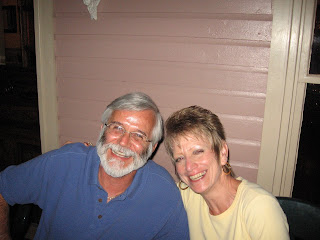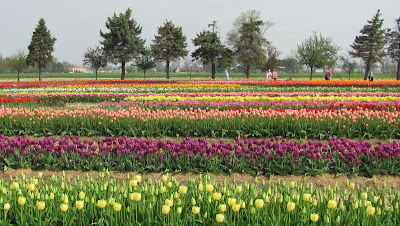We moved to the Illinois State Fairgrounds in Springfield to continue our tour of Presidential sites. Springfield was the home of Abraham Lincoln for the 25 years before he moved to Washington to become President in 1861 and became his final resting place following his assassination in 1865. While in Springfield he became a successful lawyer and served in the Illinois legislature and the US House of Representatives. Lincoln married Mary Todd and his four sons were born here. One son, Edward, died here in 1850 and another son, Willie, died in the White House in 1862. His youngest son, Tad, died in 1871 while Robert, the only child to live beyond his teens, served as Secretary of War and was president of the Pullman Car Company.

Lincoln's Springfield home.
Abe's home was originally one story but as his family grew and he prospered as a lawyer a second floor was added. The park service has done a great job of restoring the neighborhood around
Lincoln's Home. In the four surrounding blocks the homes that were there when Lincoln lived here appear as they did at that time, while those built more recently have been removed. You get a real feel for what the area looked like when the Lincoln's lived here.

There are only a few original furnishings in the home as the Lincolns rented the house and took most of their personal belongings to Washington when he was elected President. Mary would not live in the house following his death. The home is typical of an upper middle class family of the time.

Some of the places around Springfield that are tied to the history of Lincoln. Top is the train station were he gave his farewell speech when they left in 1861 and the old state capitol building where he served in the legislature. Middle is a statue of the Lincolns in front of his law office and bottom are some of the restored homes in his old neighborhood.
The tomb was dedicated in 1874 and is the final resting place of Lincoln, his wife Mary, sons Edward, Willie and Tad. Robert is buried in Arlington National Cemetery. The granite obelisk rises 117 feet and is surrounded by statues that represent the four Civil War services infantry, navy, artillery and cavalry. The military statues were cast with metal from cannons. There is a statue of Lincoln holding the Emancipation Proclamation and a plaque with an eagle holding the broken chain of human slavery in its beak.

The burial chamber.
There are reduced scale reproductions of several Lincoln statues and excerpts of several of his speeches in the halls leading to the chamber. It is said that rubbing the nose of the statue outside will bring good luck and we are never ones to pass that kind of opportunity.

A must see in Springfield is the new
Lincoln Presidential Library and Museum that opened in 2005. There are two very well done multi-media presentations, one on the role of the library and the other about Lincoln during the Civil War. The log cabin is the entrance to the exhibit on Abe's early life that includes the tragedies he suffered growing up when his mother, his first love and a son died. It follows his life as he educates himself and passes the bar and his political career, both successful and unsuccessful. This includes his debates with Stephen Douglas who defeated Lincoln in a run for the US Senate but lost the Presidential election to Abe two years later.

The Lincoln family in front of the White House that is the entrance to the exhibits about Lincoln's time as President. Standing on the left is John Wilkes Booth. This area deals with how Lincoln's election lead to the secession of the Southern states and the burden of leadership the Civil War placed on Lincoln. A must see exhibit condenses the war to four minutes with each second representing a week. A map shows how land changed hands and tracks the causalities that added up to over 1.5 million. There are exhibits about the assassination and a large room with the casket as it lie in state in the Illinois capitol. This museum is very well done and should be on the to do list of all Americans who want to understand how this great man saved the country we know.

As with most places we visit there always seems to be a reason to return. In Springfield it is the Dana-Thomas House that was designed by Frank Lloyd Wright. It is undergoing a major renovation and is not open at this time.
 We brought back a LOT of beads from Mardi Gras and shared a few with the lunch group. Top left is Becky and Sandy, right is Lena and Linda and bottom is Paul and John. We also gave two boxes of beads to my old colleagues at school. They were ooohing and aaahing so much I hope they share them with the kids. It was great seeing all of them and catching up with what has been happening here.
We brought back a LOT of beads from Mardi Gras and shared a few with the lunch group. Top left is Becky and Sandy, right is Lena and Linda and bottom is Paul and John. We also gave two boxes of beads to my old colleagues at school. They were ooohing and aaahing so much I hope they share them with the kids. It was great seeing all of them and catching up with what has been happening here. One of our favorite things about being in PA is the chance to go fishing at Pymatuning. We had a great weekend of weather and fishing with Mike and Sherri at their cottage and going out on their pontoon boat. We caught quite a few perch, catfish and walleye and enjoyed the time together.
One of our favorite things about being in PA is the chance to go fishing at Pymatuning. We had a great weekend of weather and fishing with Mike and Sherri at their cottage and going out on their pontoon boat. We caught quite a few perch, catfish and walleye and enjoyed the time together. At the lake we had a real thrill when we saw this eagle swoop down and pick a fish out of the water. Click on the pic to enlarge it and you can see the fish in the eagle's claws.
At the lake we had a real thrill when we saw this eagle swoop down and pick a fish out of the water. Click on the pic to enlarge it and you can see the fish in the eagle's claws. In addition to old friends we also saw some new ones when Dan and Merlene, who we met at Betty's, stopped by for a couple days. It was nice enough that we ate dinner on the patio of the Speers Grill overlooking the Monongahela River. Many, many times we meet up with RV friends along the way and it is always great to share our adventures.
In addition to old friends we also saw some new ones when Dan and Merlene, who we met at Betty's, stopped by for a couple days. It was nice enough that we ate dinner on the patio of the Speers Grill overlooking the Monongahela River. Many, many times we meet up with RV friends along the way and it is always great to share our adventures. 
















 The Lincoln Tomb
The Lincoln Tomb
 A must see in Springfield is the new
A must see in Springfield is the new 















